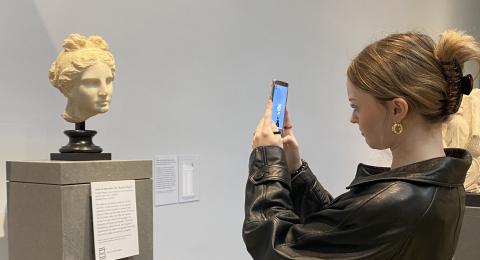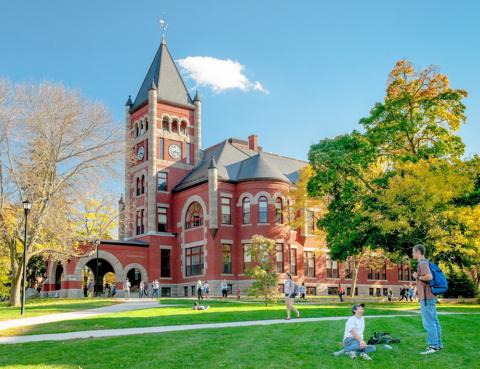The Art History major at UNH explores how beauty is defined and valued and the role of visual art in human experience. Here you'll study Western art from ancient to modern times, while also learning about non-Western cultures and traditions. Graduates are prepared for careers in the arts or to further their studies in fields like architecture, business, or law. The program offers a supportive community, proximity to cultural hubs across New England, and opportunities for dual study in art history and studio art, with available scholarships for students.
What is art history?
How do we define and value beauty? What is the role of the visual in the human experience? Art history is the study of art through the ages, and in this degree program you’ll learn to research, interpret and analyze art within broader cultural and historical perspectives. You’ll undertake a comprehensive, in-depth study of Western art from the ancient world to the present, and also be exposed to non-Western cultures and artistic traditions. Our graduates are well prepared for careers within the arts, as well as further study in fields such as architecture, business or law.
Why study art history at UNH?
a large university. Our campus is located within easy visiting distance of the culturally rich community of Portsmouth, as well as museums (the Currier in Manchester, the Peabody-Essex in Salem, the Portland Museum of Art, and the MFA and Gardner in Boston, among others). You will also have the opportunity to develop as an artist by pursuing a dual option in art history and studio art. Be sure to look for scholarship opportunities, including for incoming students, on the department website under the“Opportunities” tab.
Potential careers
- Architect
- Art critic
- Art librarian
- Art teacher
- Artist
- Gallery curator
- Museum curator
- Publisher
- Travel guide
- Writer
Curriculum & Requirements
The art history curriculum provides a comprehensive, in-depth study of Western art from the ancient world to the present as well as some exposure to non-Western cultures and artistic traditions. All courses in the program teach basic skills of interpretation and critical analysis within the framework of broad cultural perspectives that connect the visual arts to larger historical developments. They also teach good writing and research skills. In addition, art history majors typically branch out into other fields, such as history, literature and foreign languages. By the time they graduate, most majors are well equipped to pursue such traditional careers in the field as museum and gallery work, teaching, publishing or librarianship. But because art historical education is so broad, it also prepares students for a variety of other, more flexible options, such as law, business or architecture.
Degree Requirements
All Major, Option and Elective Requirements as indicated.
*Major GPA requirements as indicated.
Major Requirements
- Students must complete a minimum of 10 courses (40 credits) for the major requirements, plus a capstone course as outlined below.
- Major courses must be completed with a minimum grade of C-. The required minimum overall GPA in major coursework is 2.0.
- Art history majors may use two major-required courses to satisfy two Discovery Program category requirements.
| Code | Title | Credits |
|---|---|---|
| Required Courses | ||
| ARTH 400 | Topics in Art History | 4 |
| or ARTH 440A | From Digging to Digital: Preserving and Displaying the Past | |
| or ARTH 444 | Mona Lisa to Much Ado About Nothing: An Introduction to Renaissance Culture | |
| or ARTH 444B | Art and Money | |
| or ARTH 474 | Introduction to Architectural History | |
| or ARTH 480 | Introduction to Art History | |
| or ARTH 485 | Introduction to Global Art History | |
| ARTS 532 | Introductory Drawing 1 | 4 |
| ARTH 799 | Seminar in Art History | 4 |
| Art History Courses | ||
| Six (6) courses total from the areas below (only one 500-level course may be taken). | ||
| Pre-Renaissance - Select one course from the following: | 4 | |
ARTH 501 | Introduction to Mediterranean Archaeology | |
ARTH 674 | Greek Art and Architecture | |
ARTH 678 | Romanesque and Gothic Art | |
| Renaissance/Baroque - Select one course from the following: | 4 | |
ARTH 583 | Baroque Art: Realism, Caricature, Shock | |
ARTH 681 | Early Renaissance Art | |
ARTH 682 | The High Renaissance | |
| Modern Art - Select one course from the following: | 4 | |
ARTH 686 | Sex and Sensuality in 18th-Century Art | |
ARTH 688 | Histories of Late 19th & 20th Century European Modernism | |
ARTH 694 | Vision and Modernity: From Panorama to Early Film | |
| Electives: Pre-Renaissance, Baroque or Modern Art | 12 | |
Select three courses from the following: | ||
ARTH 501 | Introduction to Mediterranean Archaeology | |
ARTH 502 | Ancient Pompeii and the Bay of Naples | |
ARTH 583 | Baroque Art: Realism, Caricature, Shock | |
ARTH 674 | Greek Art and Architecture | |
ARTH 678 | Romanesque and Gothic Art | |
ARTH 681 | Early Renaissance Art | |
ARTH 682 | The High Renaissance | |
ARTH 686 | Sex and Sensuality in 18th-Century Art | |
ARTH 694 | Vision and Modernity: From Panorama to Early Film | |
| Capstone | ||
| ARTH 795 | Understanding Art History: An In-Depth Overview | 4 |
| Total Credits | 40 | |
- 1
Art history students receive preferential placement in this course.
For students considering graduate school recommended languages are German, and, if possible, either French, Italian, or another language relevant to their areas of interest.
Program Learning Outcomes
- We expect our art history majors to become conversant with some of the major conventions artists and architects have subscribed to over the millenia, and with how these have been bent or broken and why.
- We expect them to learn to write cogently and clearly, and to be able to analyze orally on the spot what they see in a work of art or architecture, often by comparison and contrast with works they know well.
Explore Program Details
Students can elect to receive a B.A. in the Arts with both the Studio Art option and the Art History option. Students must complete the requirements for both options; no more than 8 credits used to satisfy one option can be used as requirements for the other option. Please contact your advisor for more information.
The Department of Art and Art History awards a scholarship specifically for incoming, first-year art history students, the Edwin & Mary Scheier Incoming Freshman Art History Scholarship. Please contact the art history coordinator as early as possible if you wish to be considered for this scholarship. Your letter should describe your interest in art history.









